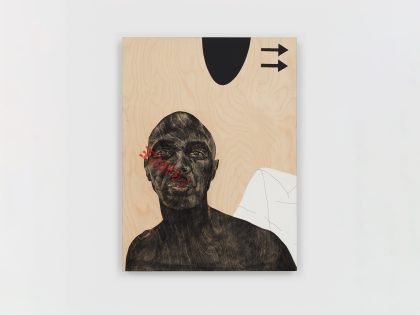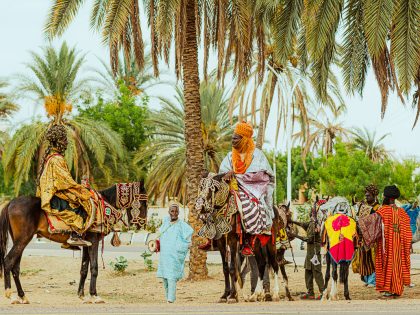Not in My Name
What's it like seeing your work on display, only to realize it's been taken over and remade by someone else to give a totally different meaning.

Credit: Medu Arts Emsemble.
In his book Art and The End of Apartheid, John Peffer writes about the Medu Art Ensemble: “For them a true culture of the people would be one that was not exclusive to the elite of the world of art galleries, but was seen in the streets, on T-shirts and posters (…).” There is thus a certain amount of irony attached to the fact that some of their posters, which served as motivation for the struggle against Apartheid in South Africa, can be found in Goodman Gallery in a Johannesburg these days. But not as we know them. This time, the slogans on these posters have been changed to make a comment on the current state of South Africa, and particularly the ruling party, the ANC. Judy Seidman, the original creator of some of these posters reacts in an open letter which we obtained earlier this week — Editors.
Every artist gets a rush from seeing their work on public display, especially if unexpected – a zing of recognition, pride, sheer ego, all at once. Today I experienced the flip side: the stomach-turning sensation brought about by unexpectedly seeing my work on display, only to realize that it has been taken over and remade by someone else to give a totally different and unacceptable meaning, and (insult to injury) hanging out there in that other artist’s name.
This happened at the current (June 2011) exhibition in the Goodman Gallery Project Space at Arts on Main. Artist Brett Murray has re-created a poster I made in 1982 with Medu Art Ensemble, exact copy line by line, with just the last word changed. The original women’s poster used the English words of the 1956 protest song “umthinta Wafasi, umthinta umbokodo” : “you have touched the women, you have struck a rock, you have dislodged a boulder, you will be crushed”. Brett Murray’s picture changes one last word, to read: “you will be president”. Presumably Murray conceives this as a sarcastic reflection on the ANCWL’s response to Jacob Zuma – he has not felt the wrath of the women, but has been raised up instead.
Another Murray artwork rips off an equally iconic poster done at CAP (not by me) in 1984, “Asiyi eKhayelitsha – we demand houses, security and comfort” (these forming demands from the freedom charter). This image is also copied exactly, with most of the words changed. In this second reworked poster, “Asiyi eKhyaelitsha” has been changed to “Amandla”; the slogan now reads “we demand chivas, BMW’s and Bribes”.
Coming home, a quick google shows these are only two of a number of “popular struggle images” that Murray has revisited. Another also rips off of my artwork, a poster designed in commemoration of Solomon Mahlangu in 1981. The original quotes Mahlangu’s words as he faced the apartheid government hangman: “Tell my people that I love them and that they must continue the struggle.” Murray edits this to read: “Tell my people that I love them and that they must continue the struggle for chivas regal, mercs and kick-backs”. These words (following the original) are in quotation marks, attributed to Solomon Mahlangu.

Murray’s website further describes five separate plaques from his 2010 Cape Town exhibition “Hail to the Thief”, separately inscribed with: ‘Chris “Hush Money” Hani. Walter “The Sweetener” Sisulu. Joe “Mr Ten Percent” Slovo. Steve “Kick-Back King” Biko. Oliver “On The Take” Tambo.’
Do not mistake me: I do not object to an artist appropriating images which have become common ground over the years, and using these to present a new message. On some level, perhaps one should be flattered that the images are public property, that people will obviously be aware that the images did not spring full-blown from Brett Murray’s artistic vision. Appropriation and change of known images is one of the ways that culture grows.
(There are limits to legitimate artistic recreation, however. In the web exhibit of “Hail to the Thief”, Murray reproduces another poster, “Why must we keep on dying this way?”, which makes no changes except in the medium –his is paint on wood rather than silkscreen– and in the title, which on the website reads “Xenophobia”. Presenting an unaltered copy of a poster from 1984 as his own work, without informing the viewer that this was done by an STP workshop with youths from the Vaal, might be considered to cross some fuzzy line of what constitutes plagiarism.)

My objection, however, is not that Murray appropriates struggle images; or even that he appropriates images that I and others created without attribution, calling them his own. My objection is that he mis-appropriates these images. These images became public, and iconic, because they told of our beliefs and our commitments during that time of struggle. Murray’s “artistic” revisions have the images saying the opposite of what we believed –suggesting that the “real” demand, in 1979 and 1982 and 1984, was for BMWs and chivas and kick-backs; and that the women’s movement of 1956 worked to make a male chauvinist who abuses women into our president. To rewrite Solomon Mahlangu’s final words to claim he fought for kick-backs is, frankly, defamatory. To make plaques “commemorating” heroes that label them as corrupt negates our history, and insults their memory.
The Goodman website describes Murray’s work as “acerbic attacks on abuses of power, corruption and political dumbness … a vitriolic and succinct censure of bad governance … (which aims) to humorously expose the paucity of morals and greed within the ruling elite.”
Praise for Murray’s “revisiting” struggle images does not end there, either. In a review of the Hail to the Thief exhibit, (ex-)struggle artist Mike Van Graan defends them thus: “One’s first reaction to these – and I imagine, that for some, it will be the only reaction – is that the artist is dishonouring the memory of these struggle icons. There will be many who play the tiresome race card and shoot the white messenger artist for his “racist attack” on black struggle heroes. When the emotional dust settles, and the politically correct (or rather, the politically opportunistic – where blackness is appropriated as a smokescreen under which to pursue and justify dubiously-gotten gain) knee-jerk reactions subside, the realisation dawns that Murray is but giving artistic expression to what even the ruling party’s closest political allies have been vociferous about….”
But do such images comprise a credible artistic expression denouncing today’s political abuse and corruption? To me, and I strongly believe to many others who were involved in the struggle, reworking these images conveys rather a deep and more sinister message, quite other than the (brave and laudable) condemnation of bad morals and greed rampant amongst our current rulers. In re-constructing and undermining historical struggle images and messages, even to misquoting the words of our heroes, Murray suggests that bad morals and greed formed the underlying motivation for our struggle. That the roots of today’s failure grow from fault-lines integral to the struggle itself.
Whether this “message” was Murray’s intention is almost irrelevant: it is the impact of his “reworking” these public images. I would argue that if this message is not his intention, but an unfortunate by-product of the form he uses, then we must dismiss his work as artistic failure: it conveys a wrong, unintended message.
Murray’s distortion of iconic images invokes outrage, but does not actually pinpoint the problem of corrupt politicians facing us today. Ultimately it counts as a cheap shot – a lazy route to audience reaction. It does not help us find a way forward. Moreover, it feeds tired old stereotypes pushed by the counter-revolution – that our national liberation struggle was no more than a fight to change one group of greedy and self-seeking rulers for another.
Van Graan goes on to suggest we who reject Murray’s art demonstrate a “kneejerk” reaction based on the “tiresome race card”. Indeed, exploring this work does lead us to question, yet again, whether an artist should attempt to put words into the mouths of people that the artist sees as “the other”. And yes, this inevitably raises the spectre of how, or whether, a white, middle-class professional male artist in 2010 should take upon himself the task of rewording statements that came out of the national liberation struggle.
To Van Graan, we might say: the true heritage of struggle posters stands with the women activists who formed a purple line opposing the mobs outside Jacob Zuma’s rape trial in 2007; with the ex-combatants from Kagiso who in January of this year produced a poster which reads: No land, jobs, houses; not yet Uhuru; with protesters in the Free State where Andries Tatane died. Not in a ripped-off image being sold as a work of art for R10 000 in a privately owned up-market gallery.
Of course, any artist has a right (in some abstract freedom of speech sense) to play with words, and images, and ideas, as he sees fit.
But then, I would argue, we who encounter the work have every right to respond accordingly. To repeat: this is not an “appropriation” of our culture and our history, but a “mis-appropriation” of it. Good art – even great art – is about sharing perceptions and understandings, about building truths. Deliberate distortion of our cultural heritage does not help the viewer to understand how we lived. Rather, it obscures that actuality.
Distorting our history and our culture, and calling it art, earns a different, and more straight-forward label: we should call it, simply, bad art.



















